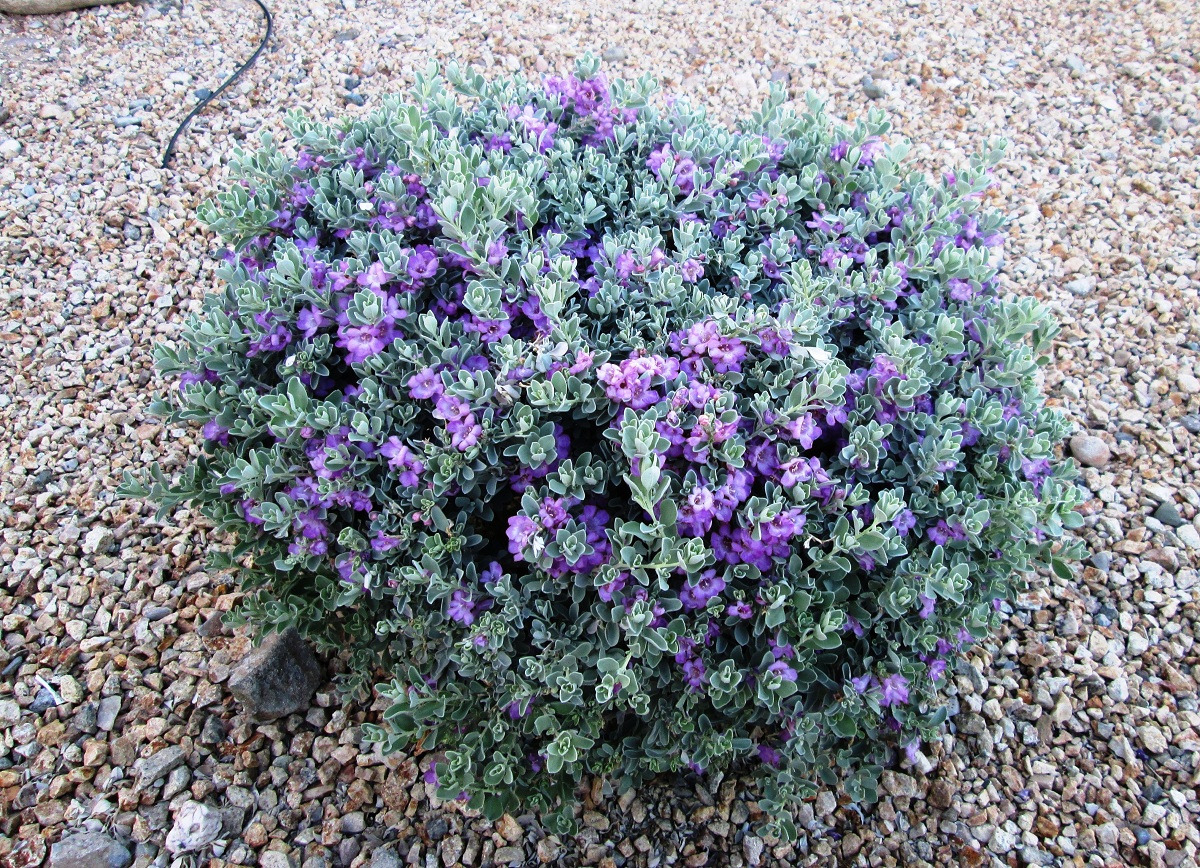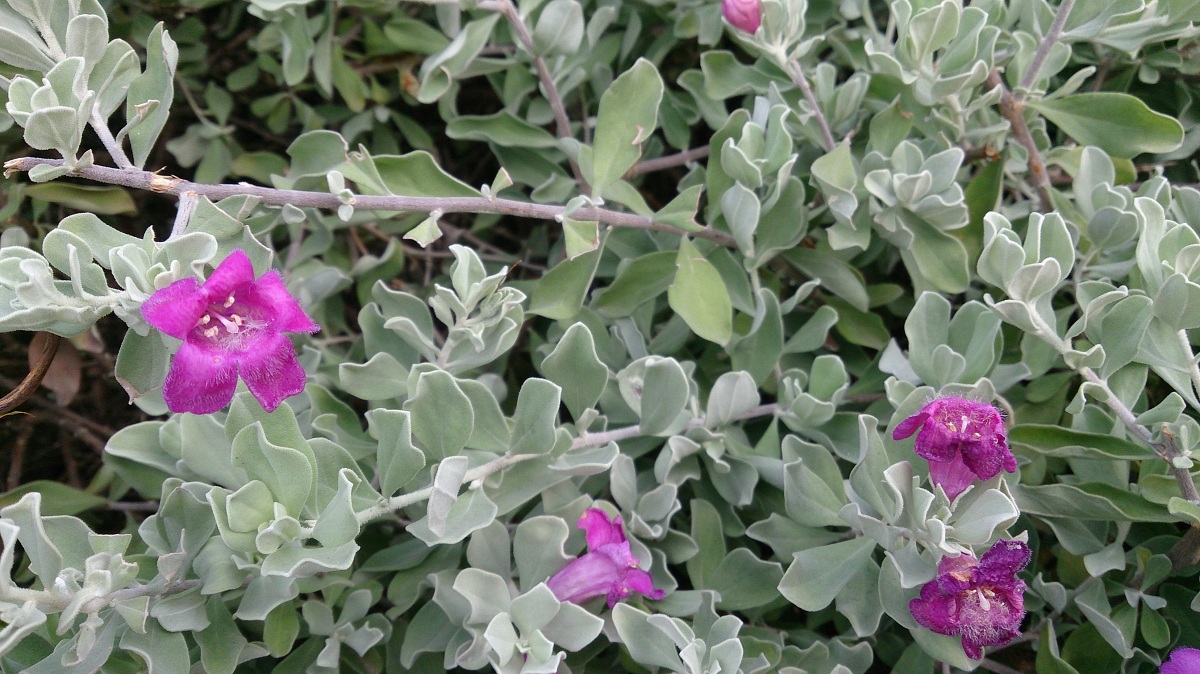
Today we are going to talk about a plant that is used for the decoration of both gardens and urban spaces and that does not have too much maintenance. Is about ashen. Its scientific name is Leucophyllum frutescens and it is an evergreen shrub that belongs to the family Scrophulariaceae, of the genus Leucophyllum. It originates from northern Mexico and the southwestern United States.
In this article we are going to tell you all the characteristics, properties and care that the ash needs.
Main characteristics of the ash plant

This shrub has bell-shaped flowers with 5 lobes and two lips. Normally, in its natural state, you cannot find sandy texture in soils since it has a great tolerance for high concentrations of salt. Over the years, ash has become one of the most popular ornamental plants since they can be placed in areas with hot and dry climates. This is because they have low your water requirements and hedges can be shaped quite easily. One of its main advantages is that it blooms over its entire surface. This makes it earn enough points when it comes to serving as an ornamental plant in urban spaces.
Shrubs are visible to the naked eye from afar with a gray appearance and leaves thickly covered with silver hairs. Its flowers have a bright pinkish-band color and are individually placed in the leaf axil. Ashen's name comes from the color of its leaves and the way it looks in general. Although it is true that it is a gray shrub, this color is due to the hairs that cover its leaves. The intense whitish gray color stands out, which makes it shine on moonlit nights and usually stands out in dark green.
In Spain the ash has the connotation of Agorero, sad, bearer of bad news, although this plant is evergreen, which indicates that it has a splendid character, it fights against the wind and the tide. It is said that he fights against the wind and the tide since it holds up well the strong winds and the spray of the salty water coming from the sea. And it is that this plant can high pH ranges but also withstands limestone rocks. One of the most important aspects for which this plant has become better known in the ornamental field is its resistance to drought.
It is unlikely to flourish in rich soils, as it prefers those soils with a sandy texture and that hold too much water.
Violet to purple flowers can sometimes be pink. Its shape is almost like bluebells and they appear intermittently from spring to autumn. The ash fruit is a small capsule.
Ash care

Since it is a perennial shrub, it has great robustness and good performance if they are used as a hedge or isolated plant in coastal areas. Thanks to its low maintenance requirements, it can be used to decorate gardens near the coast. It is a plant indicated for all those soils with characteristics semi arid and areas where the climate has little annual rainfall.
Throughout the year this plant needs to have full sun exposure. This makes it necessary that its location in the crop is necessarily in places that have enough hours of sun a day. Given its great tolerance to droughts and its low need for water, we will not need very abundant irrigation. We just have to bear in mind that, during the flowering season, the amount and frequency of watering must be increased a little. However, it is still mild and not very abundant irrigations.
When we grow this plant in gardens it does not exceed much more than a meter in height and they begin to form rounded bushes that have open branches and dense foliage. This plant it becomes quite useful and comfortable to care for all those areas where there are constantly strong wind flows. In addition, extreme heat does not harm it although persistent frosts do. If the area where you live usually has some frosts in winter with very low temperatures constantly, the ash will not be able to survive.
When it comes to sowing it, we have almost no problems in terms of the land. All those lands that have an acid nature are the least suitable for planting this shrub.
Leucophyllum risk factors

We are going to briefly summarize all the important aspects to take into account in their care and where people often fail. The first thing is to plant it on too fertile soil. It needs a poor soil that hardly retains moisture. The most normal thing is to think that a plant needs wet soil and high humidity maintenance for its correct development. However, in this case it is not. This plant needs a soil with a sandy texture and that does not retain too much water.
Overwatering causes the plant to cause root rot and quality deterioration continuously. Its flowering is more abundant in the summer season and in part of the autumn. This depends entirely on the temperatures and rainfall that have occurred during the rest of the year. If autumn temperatures remain high, flowering will last longer.
When propagating this plant it can be done by cuttings, since it does not present any difficulty. Another way to reproduce this plant is through seeds. When we sow the seeds, they only take a few weeks to germinate. Both in reproduction by cuttings and by seeds we must keep the substrate slightly moist. When the ash bush begins to develop, it will no longer need that moisture. We must ensure that the soil has a sandy texture and does not have an acidic pH.
They withstand fairly well areas with high winds and extreme drought. Therefore, we should not worry too much about irrigation.
I hope that with this information you can learn more about the ash.
This plant seems beautiful to me I have two on the terrace and I wanted to take cuttings to have other plants and I have not been able to hope these recommendations will serve me for the future and thus obtain other plants from this. Thank you for such valuable information since I hardly know finds.
I transplanted an ashlar of approximately 50 cm from a nearby unpopulated area, to a small rectangle of less than 1m square in the front of my house. As the excess water reached my pots, it grew more than 2.5 meters. Sometimes it had more flowers than deep purple leaves. But since it didn't stop growing and underneath was an electrical record of the city, I had to remove it ... I have many photographs when it was in full bloom and it looks majestic. I must add to this report that excess water never harmed it but on the contrary. I once had another one in a large pot, however, that one if I did not develop and was «down»… Greetings from Monterrey NL Mexico.
Thanks Rodrigo. It sure is useful to someone 🙂
It does not say anything about when and how the Leucophyllum was pruned.
Hi carmen.
You can prune it at the end of winter, trying to keep it with a more or less rounded shape.
A greeting.
I HAVE TRIED TO MULTIPLY IT BY CLIPPING BUT IT IS VERY DIFFICULT. VERY LOW PERCENTAGE OF ROOTING. SOME SPECIAL ADVICE REGARDING THE TYPE OF CUTTING. ITS THICKNESS, TIME. IN PERLITE IT CAN WORK.
THANK YOU
Hi carlos.
It is advisable that the cutting measures at least 20 centimeters, and that it be semi-woody. The base is impregnated with rooting hormones and planted in a pot with vermiculite (perlite dries quickly).
Of course, it is done in spring, since if it were done in any other season of the year it would have many problems to root.
Regards!
Hello. From my experience with other plants I have seen that the transparent bag works well. I put the cuttings in milk break, I make some holes in the bottom, fill them with peat and a little manure, and put a transparent bag on the outside. I have reproduced some blueberries this year like this. Also some fig trees, kiwis, kiwifruit, etc. The function of the bag is to create a fairly humid environment, so that the plant can live on the leaves, until it has roots. Try to see how it goes.
And if you have some cuttings left over, tell me and we'll talk about shipping.
Greetings.
Thanks for the information, especially regarding the soil and irrigation, since that is where I think I have failed when planting this plant.
Hello Maria.
Thank you for comment.
If you have any doubts, please contact us.
A greeting.
Good day
I have that same ash tree planted in front of my house, I live in Panama, tropical climate, we are currently in the winter season, it rains a lot but when it is sunny it stays leafy and blooms a lot. But it's been two months since he started to lose foliage, the little leaves fall off and turn yellow, he's already more than a meter tall, but now he's quite yellow and few leaves, the flowers sprout a few. what should i do to make it recover? I put a nutrient for foliage but it still continues badly. I appreciate help me